+ データを開く
データを開く
- 基本情報
基本情報
| 登録情報 |  | ||||||||||||||||||
|---|---|---|---|---|---|---|---|---|---|---|---|---|---|---|---|---|---|---|---|
| タイトル | Cryo-EM structure of corticotropin releasing factor receptor 2 bound to Urocortin 1 and coupled with heterotrimeric Go protein | ||||||||||||||||||
 マップデータ マップデータ | |||||||||||||||||||
 試料 試料 |
| ||||||||||||||||||
 キーワード キーワード | GPCR / corticotropin releasing factor receptor 2 / Urocortin 1 / Go protein / SIGNALING PROTEIN | ||||||||||||||||||
| 機能・相同性 |  機能・相同性情報 機能・相同性情報histone deacetylase inhibitor activity / corticotropin-releasing hormone receptor activity / corticotrophin-releasing factor receptor activity / corticotropin-releasing hormone receptor 2 binding / positive regulation of corticotropin secretion / positive regulation of behavioral fear response / varicosity / negative regulation of hormone secretion / drinking behavior / response to auditory stimulus ...histone deacetylase inhibitor activity / corticotropin-releasing hormone receptor activity / corticotrophin-releasing factor receptor activity / corticotropin-releasing hormone receptor 2 binding / positive regulation of corticotropin secretion / positive regulation of behavioral fear response / varicosity / negative regulation of hormone secretion / drinking behavior / response to auditory stimulus / negative regulation of appetite / corticotropin-releasing hormone receptor 1 binding / neuropeptide hormone activity / positive regulation of vascular permeability / G-protein activation / Activation of the phototransduction cascade / Glucagon-type ligand receptors / Thromboxane signalling through TP receptor / Sensory perception of sweet, bitter, and umami (glutamate) taste / G beta:gamma signalling through PI3Kgamma / G beta:gamma signalling through CDC42 / Cooperation of PDCL (PhLP1) and TRiC/CCT in G-protein beta folding / negative regulation of cell size / Activation of G protein gated Potassium channels / Inhibition of voltage gated Ca2+ channels via Gbeta/gamma subunits / Ca2+ pathway / G alpha (z) signalling events / High laminar flow shear stress activates signaling by PIEZO1 and PECAM1:CDH5:KDR in endothelial cells / Glucagon-like Peptide-1 (GLP1) regulates insulin secretion / Class B/2 (Secretin family receptors) / Vasopressin regulates renal water homeostasis via Aquaporins / G protein-coupled peptide receptor activity / Adrenaline,noradrenaline inhibits insulin secretion / ADP signalling through P2Y purinoceptor 12 / G alpha (q) signalling events / G alpha (i) signalling events / Thrombin signalling through proteinase activated receptors (PARs) / photoreceptor outer segment membrane / response to pain / negative regulation of feeding behavior / spectrin binding / positive regulation of calcium ion import / startle response / alkylglycerophosphoethanolamine phosphodiesterase activity / positive regulation of cAMP/PKA signal transduction / peptide hormone binding / positive regulation of collagen biosynthetic process / associative learning / social behavior / Synthesis, secretion, and deacylation of Ghrelin / photoreceptor outer segment / neuropeptide signaling pathway / regulation of synaptic transmission, glutamatergic / negative regulation of blood pressure / axon terminus / cardiac muscle cell apoptotic process / photoreceptor inner segment / positive regulation of cardiac muscle contraction / response to glucocorticoid / aerobic respiration / positive regulation of translation / positive regulation of DNA replication / sensory perception of sound / female pregnancy / positive regulation of interleukin-6 production / adenylate cyclase-modulating G protein-coupled receptor signaling pathway / vasodilation / long-term synaptic potentiation / neuron projection development / response to estradiol / heterotrimeric G-protein complex / sensory perception of taste / signaling receptor complex adaptor activity / retina development in camera-type eye / positive regulation of cytosolic calcium ion concentration / cell body / GTPase binding / positive regulation of cell growth / response to oxidative stress / perikaryon / G alpha (s) signalling events / phospholipase C-activating G protein-coupled receptor signaling pathway / cellular response to hypoxia / negative regulation of neuron apoptotic process / cell surface receptor signaling pathway / cell population proliferation / G protein-coupled receptor signaling pathway / negative regulation of gene expression / GTPase activity / dendrite / synapse / protein-containing complex binding / positive regulation of transcription by RNA polymerase II / extracellular region / plasma membrane / cytoplasm 類似検索 - 分子機能 | ||||||||||||||||||
| 生物種 |  Homo sapiens (ヒト) / Homo sapiens (ヒト) /  | ||||||||||||||||||
| 手法 | 単粒子再構成法 / クライオ電子顕微鏡法 / 解像度: 2.8 Å | ||||||||||||||||||
 データ登録者 データ登録者 | Zhao L-H / Lin J / Mao C / Zhou XE / Ji S / Shen D / Xiao P / Melcher K / Zhang Y / Yu X / Xu HE | ||||||||||||||||||
| 資金援助 |  中国, 中国,  米国, 5件 米国, 5件
| ||||||||||||||||||
 引用 引用 |  ジャーナル: Nat Commun / 年: 2022 ジャーナル: Nat Commun / 年: 2022タイトル: Structure insights into selective coupling of G protein subtypes by a class B G protein-coupled receptor. 著者: Li-Hua Zhao / Jingyu Lin / Su-Yu Ji / X Edward Zhou / Chunyou Mao / Dan-Dan Shen / Xinheng He / Peng Xiao / Jinpeng Sun / Karsten Melcher / Yan Zhang / Xiao Yu / H Eric Xu /   要旨: The ability to couple with multiple G protein subtypes, such as G, G, or G, by a given G protein-coupled receptor (GPCR) is critical for many physiological processes. Over the past few years, the ...The ability to couple with multiple G protein subtypes, such as G, G, or G, by a given G protein-coupled receptor (GPCR) is critical for many physiological processes. Over the past few years, the cryo-EM structures for all 15 members of the medically important class B GPCRs, all in complex with G protein, have been determined. However, no structure of class B GPCRs with G has been solved to date, limiting our understanding of the precise mechanisms of G protein coupling selectivity. Here we report the structures of corticotropin releasing factor receptor 2 (CRF2R) bound to Urocortin 1 (UCN1), coupled with different classes of heterotrimeric G proteins, G and G. We compare these structures with the structure of CRF2R in complex with G to uncover the structural differences that determine the selective coupling of G protein subtypes by CRF2R. These results provide important insights into the structural basis for the ability of CRF2R to couple with multiple G protein subtypes. | ||||||||||||||||||
| 履歴 |
|
- 構造の表示
構造の表示
| 添付画像 |
|---|
- ダウンロードとリンク
ダウンロードとリンク
-EMDBアーカイブ
| マップデータ |  emd_26104.map.gz emd_26104.map.gz | 40.1 MB |  EMDBマップデータ形式 EMDBマップデータ形式 | |
|---|---|---|---|---|
| ヘッダ (付随情報) |  emd-26104-v30.xml emd-26104-v30.xml emd-26104.xml emd-26104.xml | 20.6 KB 20.6 KB | 表示 表示 |  EMDBヘッダ EMDBヘッダ |
| 画像 |  emd_26104.png emd_26104.png | 98.7 KB | ||
| Filedesc metadata |  emd-26104.cif.gz emd-26104.cif.gz | 7.4 KB | ||
| アーカイブディレクトリ |  http://ftp.pdbj.org/pub/emdb/structures/EMD-26104 http://ftp.pdbj.org/pub/emdb/structures/EMD-26104 ftp://ftp.pdbj.org/pub/emdb/structures/EMD-26104 ftp://ftp.pdbj.org/pub/emdb/structures/EMD-26104 | HTTPS FTP |
-検証レポート
| 文書・要旨 |  emd_26104_validation.pdf.gz emd_26104_validation.pdf.gz | 544.2 KB | 表示 |  EMDB検証レポート EMDB検証レポート |
|---|---|---|---|---|
| 文書・詳細版 |  emd_26104_full_validation.pdf.gz emd_26104_full_validation.pdf.gz | 543.7 KB | 表示 | |
| XML形式データ |  emd_26104_validation.xml.gz emd_26104_validation.xml.gz | 5.9 KB | 表示 | |
| CIF形式データ |  emd_26104_validation.cif.gz emd_26104_validation.cif.gz | 6.8 KB | 表示 | |
| アーカイブディレクトリ |  https://ftp.pdbj.org/pub/emdb/validation_reports/EMD-26104 https://ftp.pdbj.org/pub/emdb/validation_reports/EMD-26104 ftp://ftp.pdbj.org/pub/emdb/validation_reports/EMD-26104 ftp://ftp.pdbj.org/pub/emdb/validation_reports/EMD-26104 | HTTPS FTP |
-関連構造データ
| 関連構造データ |  7ts0MC 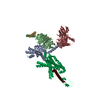 7tryC C: 同じ文献を引用 ( M: このマップから作成された原子モデル |
|---|---|
| 類似構造データ | 類似検索 - 機能・相同性  F&H 検索 F&H 検索 |
- リンク
リンク
| EMDBのページ |  EMDB (EBI/PDBe) / EMDB (EBI/PDBe) /  EMDataResource EMDataResource |
|---|---|
| 「今月の分子」の関連する項目 |
- マップ
マップ
| ファイル |  ダウンロード / ファイル: emd_26104.map.gz / 形式: CCP4 / 大きさ: 42.9 MB / タイプ: IMAGE STORED AS FLOATING POINT NUMBER (4 BYTES) ダウンロード / ファイル: emd_26104.map.gz / 形式: CCP4 / 大きさ: 42.9 MB / タイプ: IMAGE STORED AS FLOATING POINT NUMBER (4 BYTES) | ||||||||||||||||||||||||||||||||||||
|---|---|---|---|---|---|---|---|---|---|---|---|---|---|---|---|---|---|---|---|---|---|---|---|---|---|---|---|---|---|---|---|---|---|---|---|---|---|
| 投影像・断面図 | 画像のコントロール
画像は Spider により作成 | ||||||||||||||||||||||||||||||||||||
| ボクセルのサイズ | X=Y=Z: 1.014 Å | ||||||||||||||||||||||||||||||||||||
| 密度 |
| ||||||||||||||||||||||||||||||||||||
| 対称性 | 空間群: 1 | ||||||||||||||||||||||||||||||||||||
| 詳細 | EMDB XML:
|
-添付データ
- 試料の構成要素
試料の構成要素
-全体 : Corticotropin releasing factor receptor 2 (CRF2R) bound to Urocor...
| 全体 | 名称: Corticotropin releasing factor receptor 2 (CRF2R) bound to Urocortin 1 (UCN1) and coupled with G11 proteins |
|---|---|
| 要素 |
|
-超分子 #1: Corticotropin releasing factor receptor 2 (CRF2R) bound to Urocor...
| 超分子 | 名称: Corticotropin releasing factor receptor 2 (CRF2R) bound to Urocortin 1 (UCN1) and coupled with G11 proteins タイプ: complex / ID: 1 / 親要素: 0 / 含まれる分子: all |
|---|---|
| 由来(天然) | 生物種:  Homo sapiens (ヒト) Homo sapiens (ヒト) |
-分子 #1: Corticotropin-releasing factor receptor 2,Corticotropin-releasing...
| 分子 | 名称: Corticotropin-releasing factor receptor 2,Corticotropin-releasing factor receptor 2,Corticotropin-releasing factor receptor 2,Corticotropin-releasing factor receptor 2,Human corticotropin ...名称: Corticotropin-releasing factor receptor 2,Corticotropin-releasing factor receptor 2,Corticotropin-releasing factor receptor 2,Corticotropin-releasing factor receptor 2,Human corticotropin releasing factor receptor 2 タイプ: protein_or_peptide / ID: 1 / コピー数: 1 / 光学異性体: LEVO |
|---|---|
| 由来(天然) | 生物種:  Homo sapiens (ヒト) Homo sapiens (ヒト) |
| 分子量 | 理論値: 63.716246 KDa |
| 組換発現 | 生物種:  |
| 配列 | 文字列: DAALLHSLLE ANCSLALAEE LLLDGWGPPL DPEGPYSYCN TTLDQIGTCW PRSAAGALVE RPCPEYFNGV KYNTTRNAYR ECLENGTWA SKINYSQCEP ILDDKQRKYD LHYRIALVVN YLGHCVSVAA LVAAFLLFLA LRSIRCLRNV IHWNLITTFI L RNVMWFLL ...文字列: DAALLHSLLE ANCSLALAEE LLLDGWGPPL DPEGPYSYCN TTLDQIGTCW PRSAAGALVE RPCPEYFNGV KYNTTRNAYR ECLENGTWA SKINYSQCEP ILDDKQRKYD LHYRIALVVN YLGHCVSVAA LVAAFLLFLA LRSIRCLRNV IHWNLITTFI L RNVMWFLL QLVDHEVHES NEVWCRCITT IFNYFVVTNF FWMFVEGCYL HTAIVMTYST ERLRKCLFLF IGWCIPFPII VA WAIGKLY YENEQCWFGK EPGDLVDYIY QGPIILVLLI NFVFLFNIVR ILMTKLRAST TSETIQYRKA VKATLVLLPL LGI TYMLFF VNPGEDDLSQ IMFIYFNSFL QSFQGFFVSV FYCFFNGEVR SAVRKRWHRW QDHHSLRVPM AGSSGGGGSG GGGS SGVFT LEDFVGDWEQ TAAYNLDQVL EQGGVSSLLQ NLAVSVTPIQ RIVRSGENAL KIDIHVIIPY EGLSADQMAQ IEEVF KVVY PVDDHHFKVI LPYGTLVIDG VTPNMLNYFG RPYEGIAVFD GKKITVTGTL WNGNKIIDER LITPDGSMLF RVTINS UniProtKB: Corticotropin-releasing factor receptor 2 |
-分子 #2: Urocortin
| 分子 | 名称: Urocortin / タイプ: protein_or_peptide / ID: 2 / コピー数: 1 / 光学異性体: LEVO |
|---|---|
| 由来(天然) | 生物種:  Homo sapiens (ヒト) Homo sapiens (ヒト) |
| 分子量 | 理論値: 4.703277 KDa |
| 配列 | 文字列: DNPSLSIDLT FHLLRTLLEL ARTQSQRERA EQNRIIFDSV UniProtKB: Urocortin |
-分子 #3: Dominant negative Go alpha subunit
| 分子 | 名称: Dominant negative Go alpha subunit / タイプ: protein_or_peptide / ID: 3 / コピー数: 1 / 光学異性体: LEVO |
|---|---|
| 由来(天然) | 生物種:  Homo sapiens (ヒト) Homo sapiens (ヒト) |
| 分子量 | 理論値: 40.032488 KDa |
| 組換発現 | 生物種:  |
| 配列 | 文字列: MGCTLSAEDK AAVERSKMID RNLREDGEKA AKDVKLLLLG AGESGKSTIV KQMKIIHEAG YSEEECKQYK AVVYSNTIQS IIAIIRAMG RLKIDFGDSA RADDARQLFV LAGAAEEGFM TAELAGVIKR LWKDSGVQAC FNRSREYQLN DSAAYYLNDL D RIAQPNYI ...文字列: MGCTLSAEDK AAVERSKMID RNLREDGEKA AKDVKLLLLG AGESGKSTIV KQMKIIHEAG YSEEECKQYK AVVYSNTIQS IIAIIRAMG RLKIDFGDSA RADDARQLFV LAGAAEEGFM TAELAGVIKR LWKDSGVQAC FNRSREYQLN DSAAYYLNDL D RIAQPNYI PTQQDVLRTR VKTTGIVETH FTFKNLHFRL FDVGAQRDER RKWIHCFEDV TAIIFCVALS GYDQVLHEDE TT NRMQESL NLFKSICNNK FFIDTSIILF LNKKDLFGEK IKKSPLTICF PEYTGPNTYE DAAAYIQAQF ESKNRSPNKE IYC HMTCST DTNNIQVVFD AVTDIIIANN LRGCGLY |
-分子 #4: Guanine nucleotide-binding protein G(I)/G(S)/G(T) subunit beta-1
| 分子 | 名称: Guanine nucleotide-binding protein G(I)/G(S)/G(T) subunit beta-1 タイプ: protein_or_peptide / ID: 4 / コピー数: 1 / 光学異性体: LEVO |
|---|---|
| 由来(天然) | 生物種:  |
| 分子量 | 理論値: 43.70675 KDa |
| 組換発現 | 生物種:  |
| 配列 | 文字列: MHHHHHHSSG LVPRGSHMAS HHHHHHHHHH GSLLQSELDQ LRQEAEQLKN QIRDARKACA DATLSQITNN IDPVGRIQMR TRRTLRGHL AKIYAMHWGT DSRLLVSASQ DGKLIIWDSY TTNKVHAIPL RSSWVMTCAY APSGNYVACG GLDNICSIYN L KTREGNVR ...文字列: MHHHHHHSSG LVPRGSHMAS HHHHHHHHHH GSLLQSELDQ LRQEAEQLKN QIRDARKACA DATLSQITNN IDPVGRIQMR TRRTLRGHL AKIYAMHWGT DSRLLVSASQ DGKLIIWDSY TTNKVHAIPL RSSWVMTCAY APSGNYVACG GLDNICSIYN L KTREGNVR VSRELAGHTG YLSCCRFLDD NQIVTSSGDT TCALWDIETG QQTTTFTGHT GDVMSLSLAP DTRLFVSGAC DA SAKLWDV REGMCRQTFT GHESDINAIC FFPNGNAFAT GSDDATCRLF DLRADQELMT YSHDNIICGI TSVSFSKSGR LLL AGYDDF NCNVWDALKA DRAGVLAGHD NRVSCLGVTD DGMAVATGSW DSFLKIWNGS SGGGGSGGGG SSGVSGWRLF KKIS UniProtKB: Guanine nucleotide-binding protein G(I)/G(S)/G(T) subunit beta-1 |
-分子 #5: G protein gamma subunit
| 分子 | 名称: G protein gamma subunit / タイプ: protein_or_peptide / ID: 5 / コピー数: 1 / 光学異性体: LEVO |
|---|---|
| 由来(天然) | 生物種:  |
| 分子量 | 理論値: 7.861143 KDa |
| 組換発現 | 生物種:  |
| 配列 | 文字列: MASNNTASIA QARKLVEQLK MEANIDRIKV SKAAADLMAY CEAHAKEDPL LTPVPASENP FREKKFFCAI L |
-分子 #6: scFV16
| 分子 | 名称: scFV16 / タイプ: protein_or_peptide / ID: 6 / コピー数: 1 / 光学異性体: LEVO |
|---|---|
| 由来(天然) | 生物種: synthetic construct (人工物) |
| 分子量 | 理論値: 26.277299 KDa |
| 組換発現 | 生物種:  |
| 配列 | 文字列: VQLVESGGGL VQPGGSRKLS CSASGFAFSS FGMHWVRQAP EKGLEWVAYI SSGSGTIYYA DTVKGRFTIS RDDPKNTLFL QMTSLRSED TAMYYCVRSI YYYGSSPFDF WGQGTTLTVS AGGGGSGGGG SGGGGSADIV MTQATSSVPV TPGESVSISC R SSKSLLHS ...文字列: VQLVESGGGL VQPGGSRKLS CSASGFAFSS FGMHWVRQAP EKGLEWVAYI SSGSGTIYYA DTVKGRFTIS RDDPKNTLFL QMTSLRSED TAMYYCVRSI YYYGSSPFDF WGQGTTLTVS AGGGGSGGGG SGGGGSADIV MTQATSSVPV TPGESVSISC R SSKSLLHS NGNTYLYWFL QRPGQSPQLL IYRMSNLASG VPDRFSGSGS GTAFTLTISR LEAEDVGVYY CMQHLEYPLT FG AGTKLEL |
-実験情報
-構造解析
| 手法 | クライオ電子顕微鏡法 |
|---|---|
 解析 解析 | 単粒子再構成法 |
| 試料の集合状態 | particle |
- 試料調製
試料調製
| 緩衝液 | pH: 7.5 |
|---|---|
| 凍結 | 凍結剤: ETHANE |
- 電子顕微鏡法
電子顕微鏡法
| 顕微鏡 | FEI TITAN KRIOS |
|---|---|
| 撮影 | フィルム・検出器のモデル: GATAN K2 SUMMIT (4k x 4k) 平均電子線量: 64.0 e/Å2 |
| 電子線 | 加速電圧: 300 kV / 電子線源:  FIELD EMISSION GUN FIELD EMISSION GUN |
| 電子光学系 | 照射モード: FLOOD BEAM / 撮影モード: BRIGHT FIELD / 最大 デフォーカス(公称値): 4.0 µm / 最小 デフォーカス(公称値): 1.0 µm |
| 実験機器 |  モデル: Titan Krios / 画像提供: FEI Company |
 ムービー
ムービー コントローラー
コントローラー



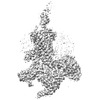







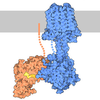
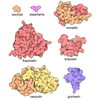
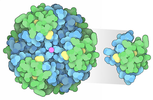

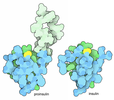

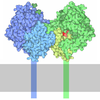
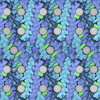
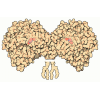
 Z (Sec.)
Z (Sec.) Y (Row.)
Y (Row.) X (Col.)
X (Col.)





















